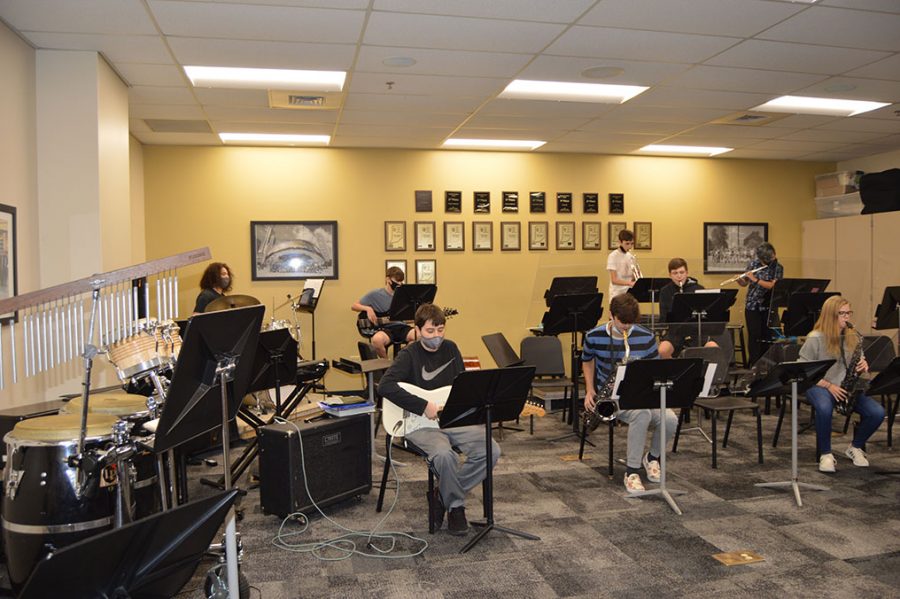Stand shields and safety: Senior Vincent Hammer creates stand covers to protect students
Photo by K. Gorsuch
Jazz teacher Bethany Robinson’s Jazz 4 class rehearses using their Plexiglass stands.
October 8, 2020
You are sitting in the middle of your band class wondering how the world as a musician has become increasingly more dangerous due to COVID-19 with the risk of air leaking out of your instrument and the sides of your classmates’ mouths. There are ways to keep yourself and others safe during band classes: bell covers, social distancing, wearing masks whenever not playing, but what if you’re in a small classroom where it is difficult to socially distance? NHS Senior Vincent Hammer came up with a solution to this problem—plexiglass shields that cover the entire music stand to keep any air from escaping and getting to those around you.
After first designing a plexiglass stand prototype in order to keep the directors safe, Vincent and jazz band director Bethany Robinson began discussing a way to keep all of the students safe. This is how they came up with the idea of the plexiglass stand shields for each individual stand in the band room.
“Once we realized that we would be back in school…we wanted to be ready for anything,” said Robinson. “I have a small music room, definitely the smallest music room where students are playing wind instruments.”
The music department already bought plastic bell covers for each student’s instrument that caught all of the condensation from the air that comes out of the bell. Once Robinson and Hammer started talking about another layer of protection, however, they decided on the stand shields.
“A lot of times in a music studio they will actually have plexiglass as a way to contain the sound. I hadn’t seen anything like it specifically but when I asked Vincent about it he immediately [said] ‘Yes, let me go make a prototype’ and he brought it back,” Robinson said.
The shields definitely have affected class for jazz band students, but according to students it has been in a good way.
“I think that the plexiglass covers paired with masks is probably the safest option for band students,” sophomore Mikaela Westlund said. “The mask protects us from others while we sit in class not playing, while the stand cover helps keep the air that comes out of the instruments more isolated in one place.”
According to students, there can be many upsides to the shields, the biggest being protection, but there can be a few minor downsides as well.
“The biggest effect they have on me is the fact that I now have to walk around the stands instead of just moving one to get to my seat,” Westlund said. “The added plexiglass puts a bit more weight on the stand as well as making the stand bigger and harder to move around.”
To solve the weight problem, Robinson added clips that she bought from Lowes and attached them to the stands in order to keep them from falling down. Another small issue with the shields is that they can affect students’ hearing, that obviously being a large factor in band. For junior trombone player Daniel Field, this issue restricts his playing to a certain degree.
“The [stand] covers aren’t really the best option because it does block out some hearing, and with the trumpets they all stand up so they play over them,” Field claims. “But if we can’t move spaces, the stands work very well versus having nothing at all.”
Despite the drawbacks to the stand shields, many jazz students would rather focus on the positives of the shields.
“For the most part,” junior trombone player Tyler Sivertsen said, “they have provided a larger space for music, and that helps when needing to look at multiple pages at once.”
Beyond the bell covers, the stands add additional safety to the jazz band classrooms.
Westlund understands this and reasons “The extra protection may help in decreasing the chances of spread even more.”




